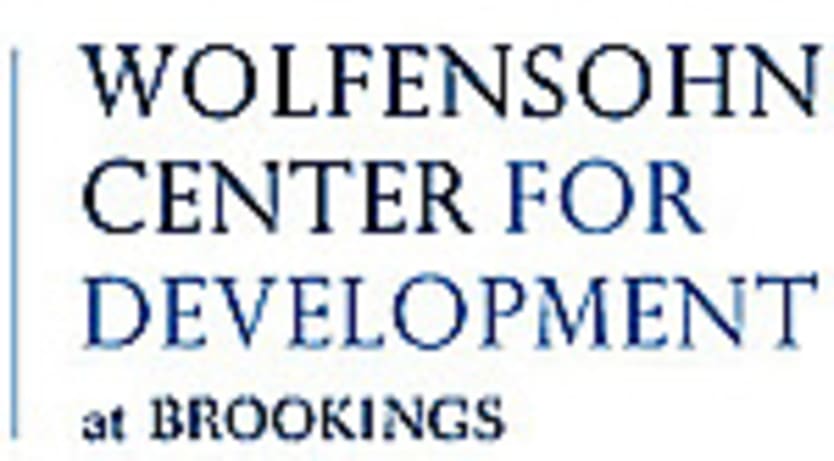
EDITOR’S NOTE: It’s not easy to create comprehensive, long-term and sustained development initiatives based on a partner country’s needs. But there are some lessons learned from past efforts, say Arntraud Hartmann, senior lecturer at the University of Applied Sciences in Berlin, and Johannes F. Linn, executive director of the Wolfensohn Center for Development at Brookings. A few excerpts:
At the Gleneagles Summit in 2005, leaders of the G8 group of nations committed to increase aid to poor nations by $50 billion per year. During the same year, in a meeting in Paris, donors promised to coordinate their interventions for more effective delivery. These commitments are now often referred to as the promise of donors to “scale up aid.”
The international donor community met this fall in Accra and will meet in Doha in November 2008 to review progress with this aspect of scaling up aid, and it is hoped that they will recommit to meet the ambitious targets set three years ago.
Scaling up aid is only one of the challenges that donors face. A more important challenge is to “scale up through aid,” meaning that aid flows should not merely support short-lived, one-time and partial development interventions.
Scaling up means that programs are long-term and sustained and that external support is aligned with country needs and deals comprehensively with the development challenges, of¬ten by working in partnership with other donors and pooling resources. This is the scaling up challenge that donors should address head-on, but so far have not.
Scaling up through aid
In 2000, the global community set itself the challenge of meeting the Millennium Development Goals (MDGs) by 2015 as a way to combat world poverty. In 2007, the halfway point, it became clear that many countries will no be able to meet the MDGs unless greater efforts are made. Confronted with this challenge, the development community has committed to scale up development aid with a focus on how to mobilize, deploy and absorb the substantially increased levels of official development assistance prom¬ised at recent G8 summits.
In response, official donors committed themselves in the “Paris Declaration” to work together for more efficient and better coordinated aid delivery.
However, the real challenge is not just how to deliver more, better coordinated and less volatile aid.
In order to reduce poverty, we have to follow the advice of James Wolfensohn and discover “how to move from our feel-good successes to large scale, how to scale up these initiatives to a depth and breadth where we can really have an impact on poverty, where we can achieve the Millennium Development Goals.” In this context, scaling up means not simply more aid, but aid that expands, adapts, and sustains successful projects, programs, or policies over time for greater development impact.
Based on this in-depth review, we summarize in this policy brief the key lessons and consider aid’s special role in the scaling up process. We end with some practical recommen¬dations for aid agencies to ensure that they effectively pursue a scaling up agenda.
Whether to scale up
The first question to ask is whether a project, a program or policy should be scaled up, and if so, how far and for how long. Should the program operate on a national, a provincial or a local level?
Scaled up interventions should not always last indefinitely. Scale limits and sunset provisions are especially important in areas where public action is taken to correct, for what are at best seen as, temporary private market failures-state banks, state marketing boards, etc. In these cases, the critical issue is how to ensure an effective enabling environment for private initiatives rather than concern over large scale and long-term public interventions.
How to scale up
Scaling up takes time-often ten to fifteen years, or more. This long time horizon poses great challenges: donors shift priorities, governments change, NGO funding is driven by fashion, agency managers and staff move on. The long time horizon requires that scaling up needs to be perceived as a systemic effort, not as a short-term fad. This requires a systematic strategy for how to scale up a basic set of institutional values and incentives, which ensure that key actors are continu¬ously searching for ways to build on successful interventions to see that they are replicated, expanded, transferred to and adapted in other settings.
There are three building blocks for how such scaling-up strategies can be designed or how basic values and incentives can be instilled. Scaling up requires vision, drivers and space in which to grow.
Vision
Ideally, vision for scaling up should be developed while the first phase of a program, or pilot, is being put in place. Pilots should be designed in such a way that they could be scaled up, if successful.The question whether scaling up is appropriate should be explicitly factored into the decision whether and how to implement the intervention in the first place.
Drivers
Scaling up is a dynamic process that needs drivers to push it forward. All successful programs taken from small to large scale have benefitted from charismatic leaders endowed with a vision, persistent in their efforts, often well connected to major stakeholders and constituencies, with the ability to build up authority and guide people.
Finally, external catalysts-crises, such as natural disasters or economic meltdowns-or the influence of outside actors can serve as drivers of change and scaling up.
Space to Grow
For interventions to be scaled up, they need space in which to grow. Sometimes, such space is readily available, but more often than not the space has to be created. Scaled up programs require:
• fiscal and financial space to support the inevitably higher expenditures, even if unit costs drop at higher scale-which is not guaranteed;• political space since supportive constituencies need to be mobilized and political opposition needs to be neutralized;• policy space by ensuring that potential policy obstacles are identified and removed;• institutional space with institutions willing or able to create and operate the larger program; this in turn requires adequate manpower, skills and processes to manage the enlarged pro¬gram and incentives to overcome typical bureaucratic inertia;• cultural space to ensure that programs working in one community also fit culturally in others;• partnership space that allows external and internal partners to support a program with fi nan¬cial, technical and political resources; and• learning space in which monitoring and evaluation feedback ensures that programs, as they grow, are adjusted based on the lessons learned.
Implications for aid and aid agencies
Donors have a particular role to play in the scaling up process. Especially in many of the poor and aid-dependent countries, this process involves complex relationship between donor and recipient agencies. This relationship tends to be one-sided, in the sense that recipients depend on the donors and need to follow donors’ preferences. Because of this unequal relationship, donors carry a special responsibility for scaling up the effort.
Progress in implementing this agenda unfortunately has been mixed, and some donors, in par¬ticular the US, do not exhibit a strong commitment to the Paris Declaration.
Donor align¬ment with government systems and government ownership as the eminent principle for interventions should help to create the policy space, the fiscal/financial space and the political space for successful programs to grow. In addition, bilateral and multilateral donors increasingly rely on joint donor financ¬ing instruments, such as sector-based lending, basket lending, sector and general budgetary support instruments-all of which also can support the scaling up of programs.
Some donor agencies have introduced the idea of “scaling up” into their strategic rhetoric and are attempting to institutionalize scaling up.
But a quick check of principal donors’ Web sites shows that these are the exceptions rather than the rule.
This leads us to the conclusion that the donor community needs a change of mindset and prac¬tices. First and foremost, defining a clear vision, applying strong leadership and instilling the institution¬al values in the aid agency to assure that the scaling up goal is systematically reflected in the institutional.
Second, aid agencies need to see the creation of “political space” as an important aspect of the programs they finance, as scaling up can only take place with political support.
Third, linking support for projects, programs and policies in a seamless web is important-the World Bank has been most advanced in this regard, but other donors could and should do more.
Fourth, helping to build the institutional capacity for scaling up is critical. Special efforts must be made to avoid setting up parallel institutions for aid-financed projects, such as the still frequently used “Project Implementation Units.
Fifth, donors must realign their own institutional incentives and accountabilities to assure that staff and mangers, strategies and programs, as well as technical advice and financing, are directed to the scaling up objective.
Sixth, donors need to get serious about harmonizing their administrative and fiduciary require¬ments. This is an area in which the Paris Declaration was to make progress, but little seems to have been achieved so far.
Seventh, donors have to overhaul their evaluation approaches.
Finally, support for a gradual, orderly and coordinated process in which other partners are brought to the table, systematic learning can take place, simple solutions for scaling up can be identi¬fied and applied, and sustained financial support is provided, should become the norm, rather than the exception.
Immediate steps to make up scaling up aid a reality
Donors could take some immediate practical steps to implement these broad priorities.
1. Paris Declaration should be broadened to include scaling up as an explicit component.2. Each agency should implement a “scaling up audit” with independent outside input.3. The donor agencies’ evaluation units should review their evaluation approaches and manu¬als and ensure that they adequately address scaling up.4. Donors individually or collectively should set up “replication funds;” these funds would pro¬vide financing, possibly on concessional terms and in the form of matching grants or loans, as an incentive for scaling up successful programs.5. Donors should expand the use of programmatic instruments that allow for going from in¬dividual projects to support for broader sector programs.6. Stakeholder analysis, political analysis, citizens’ report cards and client surveys should be introduced as routine instruments for country strategies and project appraisal.7. Donor agencies should create a network of senior managers, recipient country representa¬tives and technical experts who regularly meet to explore how scaling up initiatives can be supported across donor institutions.8. Donors should support systematic research on scaling up.
Re-published with permission by the Wolfensohn Center for Development at Brookings. Visit the original article.








